University Taxation Case Study: Deductions, Income, and Compensation
VerifiedAdded on 2021/04/21
|7
|1144
|20
Case Study
AI Summary
This document presents a detailed analysis of two taxation case studies. The first case examines allowable deductions for an individual, covering expenses like tax return fees, travel, and self-education courses, as well as the implications of not receiving bank interest. The second case study analyzes the tax treatment of weekly compensation payments and a lump-sum redemption received by an applicant, differentiating between income received before and after the age of 65 and classifying the nature of the payments as either ordinary or statutory income. The document also outlines the steps a tax agent should follow when engaging with clients and lodging tax returns, including assessing clients, examining records, and documenting the terms of engagement. The analysis relies on Australian taxation law and relevant rulings to provide a comprehensive understanding of the tax implications in each scenario.
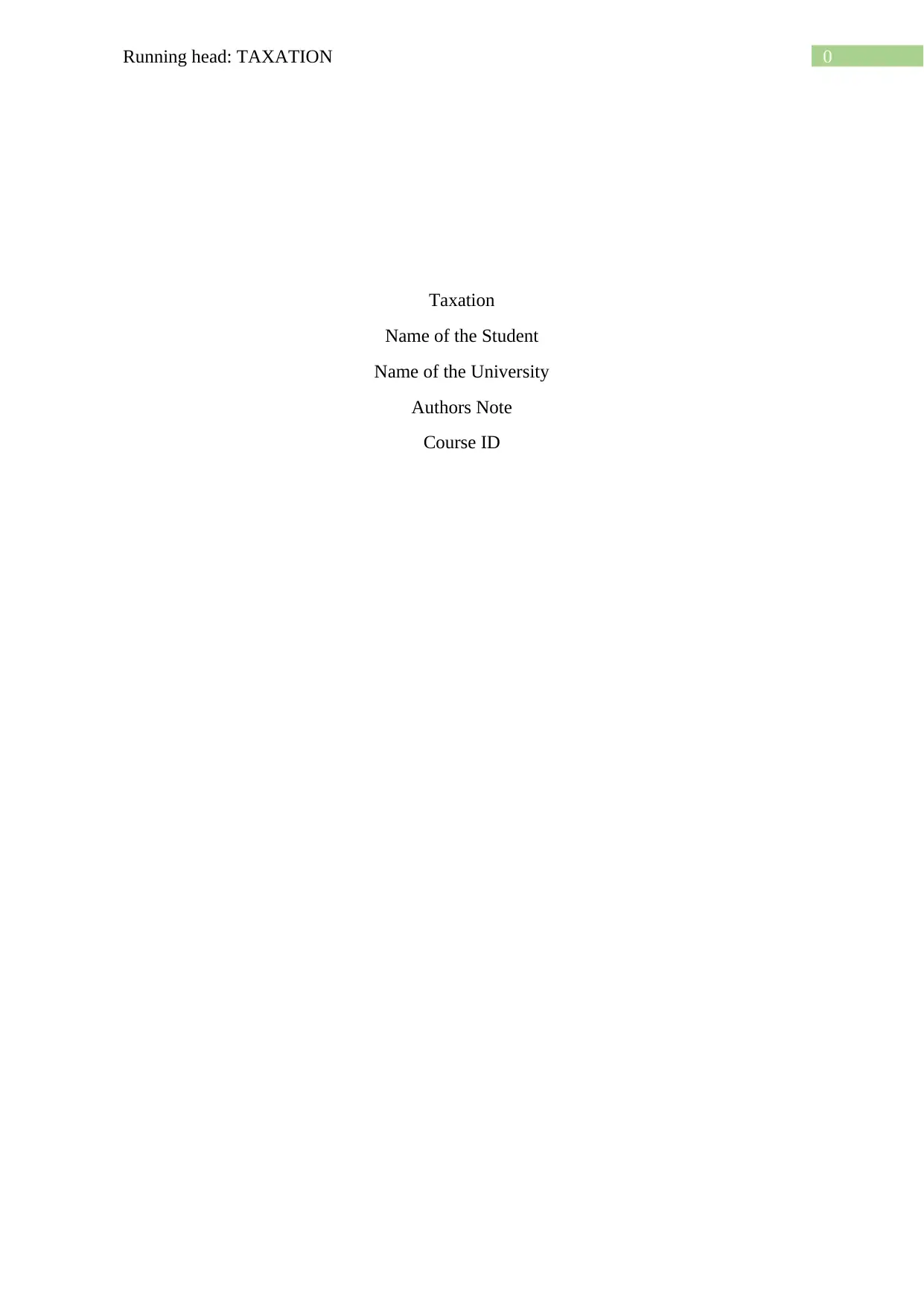
0Running head: TAXATION
Taxation
Name of the Student
Name of the University
Authors Note
Course ID
Taxation
Name of the Student
Name of the University
Authors Note
Course ID
Paraphrase This Document
Need a fresh take? Get an instant paraphrase of this document with our AI Paraphraser
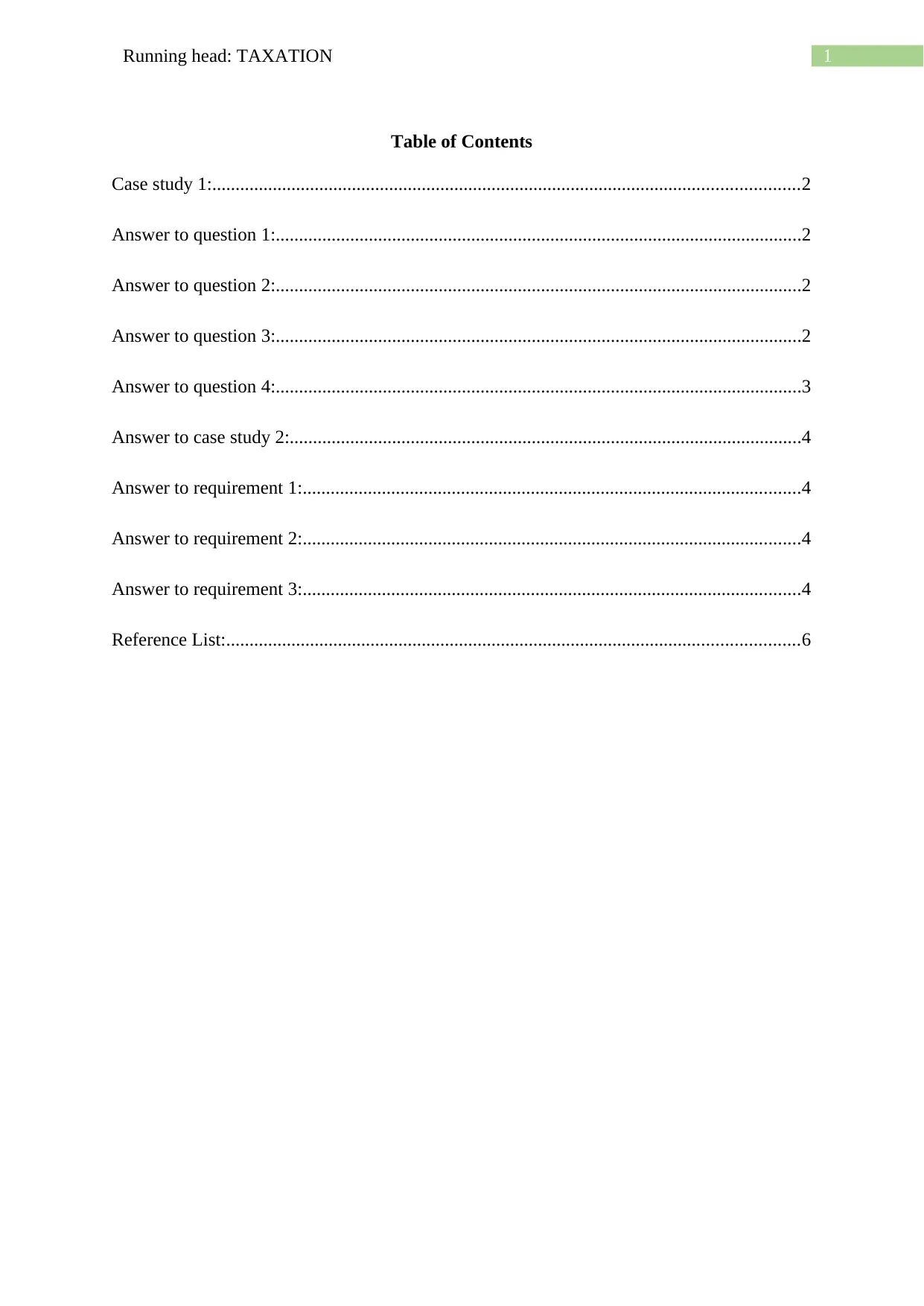
1Running head: TAXATION
Table of Contents
Case study 1:..............................................................................................................................2
Answer to question 1:.................................................................................................................2
Answer to question 2:.................................................................................................................2
Answer to question 3:.................................................................................................................2
Answer to question 4:.................................................................................................................3
Answer to case study 2:..............................................................................................................4
Answer to requirement 1:...........................................................................................................4
Answer to requirement 2:...........................................................................................................4
Answer to requirement 3:...........................................................................................................4
Reference List:...........................................................................................................................6
Table of Contents
Case study 1:..............................................................................................................................2
Answer to question 1:.................................................................................................................2
Answer to question 2:.................................................................................................................2
Answer to question 3:.................................................................................................................2
Answer to question 4:.................................................................................................................3
Answer to case study 2:..............................................................................................................4
Answer to requirement 1:...........................................................................................................4
Answer to requirement 2:...........................................................................................................4
Answer to requirement 3:...........................................................................................................4
Reference List:...........................................................................................................................6
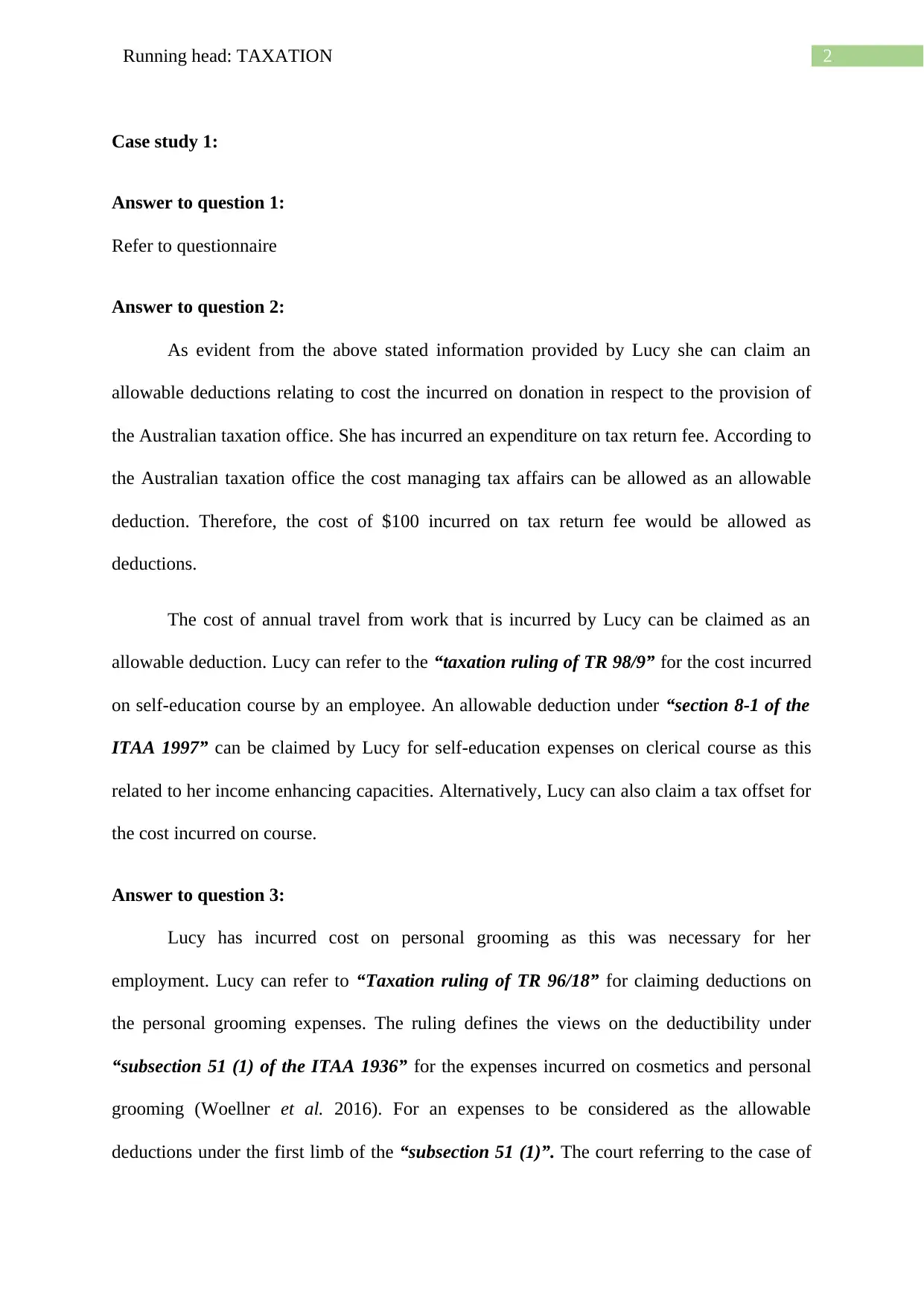
2Running head: TAXATION
Case study 1:
Answer to question 1:
Refer to questionnaire
Answer to question 2:
As evident from the above stated information provided by Lucy she can claim an
allowable deductions relating to cost the incurred on donation in respect to the provision of
the Australian taxation office. She has incurred an expenditure on tax return fee. According to
the Australian taxation office the cost managing tax affairs can be allowed as an allowable
deduction. Therefore, the cost of $100 incurred on tax return fee would be allowed as
deductions.
The cost of annual travel from work that is incurred by Lucy can be claimed as an
allowable deduction. Lucy can refer to the “taxation ruling of TR 98/9” for the cost incurred
on self-education course by an employee. An allowable deduction under “section 8-1 of the
ITAA 1997” can be claimed by Lucy for self-education expenses on clerical course as this
related to her income enhancing capacities. Alternatively, Lucy can also claim a tax offset for
the cost incurred on course.
Answer to question 3:
Lucy has incurred cost on personal grooming as this was necessary for her
employment. Lucy can refer to “Taxation ruling of TR 96/18” for claiming deductions on
the personal grooming expenses. The ruling defines the views on the deductibility under
“subsection 51 (1) of the ITAA 1936” for the expenses incurred on cosmetics and personal
grooming (Woellner et al. 2016). For an expenses to be considered as the allowable
deductions under the first limb of the “subsection 51 (1)”. The court referring to the case of
Case study 1:
Answer to question 1:
Refer to questionnaire
Answer to question 2:
As evident from the above stated information provided by Lucy she can claim an
allowable deductions relating to cost the incurred on donation in respect to the provision of
the Australian taxation office. She has incurred an expenditure on tax return fee. According to
the Australian taxation office the cost managing tax affairs can be allowed as an allowable
deduction. Therefore, the cost of $100 incurred on tax return fee would be allowed as
deductions.
The cost of annual travel from work that is incurred by Lucy can be claimed as an
allowable deduction. Lucy can refer to the “taxation ruling of TR 98/9” for the cost incurred
on self-education course by an employee. An allowable deduction under “section 8-1 of the
ITAA 1997” can be claimed by Lucy for self-education expenses on clerical course as this
related to her income enhancing capacities. Alternatively, Lucy can also claim a tax offset for
the cost incurred on course.
Answer to question 3:
Lucy has incurred cost on personal grooming as this was necessary for her
employment. Lucy can refer to “Taxation ruling of TR 96/18” for claiming deductions on
the personal grooming expenses. The ruling defines the views on the deductibility under
“subsection 51 (1) of the ITAA 1936” for the expenses incurred on cosmetics and personal
grooming (Woellner et al. 2016). For an expenses to be considered as the allowable
deductions under the first limb of the “subsection 51 (1)”. The court referring to the case of
⊘ This is a preview!⊘
Do you want full access?
Subscribe today to unlock all pages.

Trusted by 1+ million students worldwide
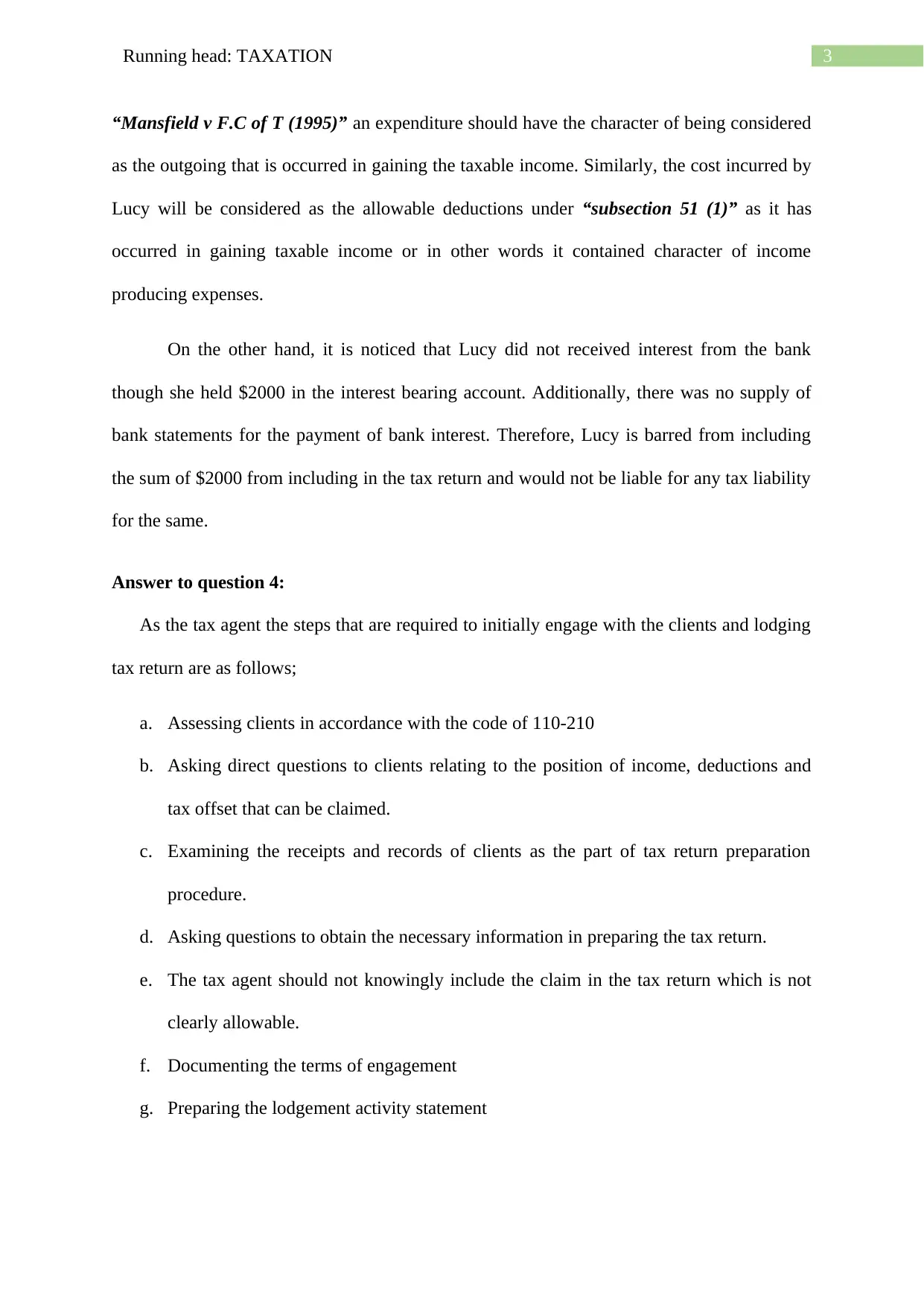
3Running head: TAXATION
“Mansfield v F.C of T (1995)” an expenditure should have the character of being considered
as the outgoing that is occurred in gaining the taxable income. Similarly, the cost incurred by
Lucy will be considered as the allowable deductions under “subsection 51 (1)” as it has
occurred in gaining taxable income or in other words it contained character of income
producing expenses.
On the other hand, it is noticed that Lucy did not received interest from the bank
though she held $2000 in the interest bearing account. Additionally, there was no supply of
bank statements for the payment of bank interest. Therefore, Lucy is barred from including
the sum of $2000 from including in the tax return and would not be liable for any tax liability
for the same.
Answer to question 4:
As the tax agent the steps that are required to initially engage with the clients and lodging
tax return are as follows;
a. Assessing clients in accordance with the code of 110-210
b. Asking direct questions to clients relating to the position of income, deductions and
tax offset that can be claimed.
c. Examining the receipts and records of clients as the part of tax return preparation
procedure.
d. Asking questions to obtain the necessary information in preparing the tax return.
e. The tax agent should not knowingly include the claim in the tax return which is not
clearly allowable.
f. Documenting the terms of engagement
g. Preparing the lodgement activity statement
“Mansfield v F.C of T (1995)” an expenditure should have the character of being considered
as the outgoing that is occurred in gaining the taxable income. Similarly, the cost incurred by
Lucy will be considered as the allowable deductions under “subsection 51 (1)” as it has
occurred in gaining taxable income or in other words it contained character of income
producing expenses.
On the other hand, it is noticed that Lucy did not received interest from the bank
though she held $2000 in the interest bearing account. Additionally, there was no supply of
bank statements for the payment of bank interest. Therefore, Lucy is barred from including
the sum of $2000 from including in the tax return and would not be liable for any tax liability
for the same.
Answer to question 4:
As the tax agent the steps that are required to initially engage with the clients and lodging
tax return are as follows;
a. Assessing clients in accordance with the code of 110-210
b. Asking direct questions to clients relating to the position of income, deductions and
tax offset that can be claimed.
c. Examining the receipts and records of clients as the part of tax return preparation
procedure.
d. Asking questions to obtain the necessary information in preparing the tax return.
e. The tax agent should not knowingly include the claim in the tax return which is not
clearly allowable.
f. Documenting the terms of engagement
g. Preparing the lodgement activity statement
Paraphrase This Document
Need a fresh take? Get an instant paraphrase of this document with our AI Paraphraser
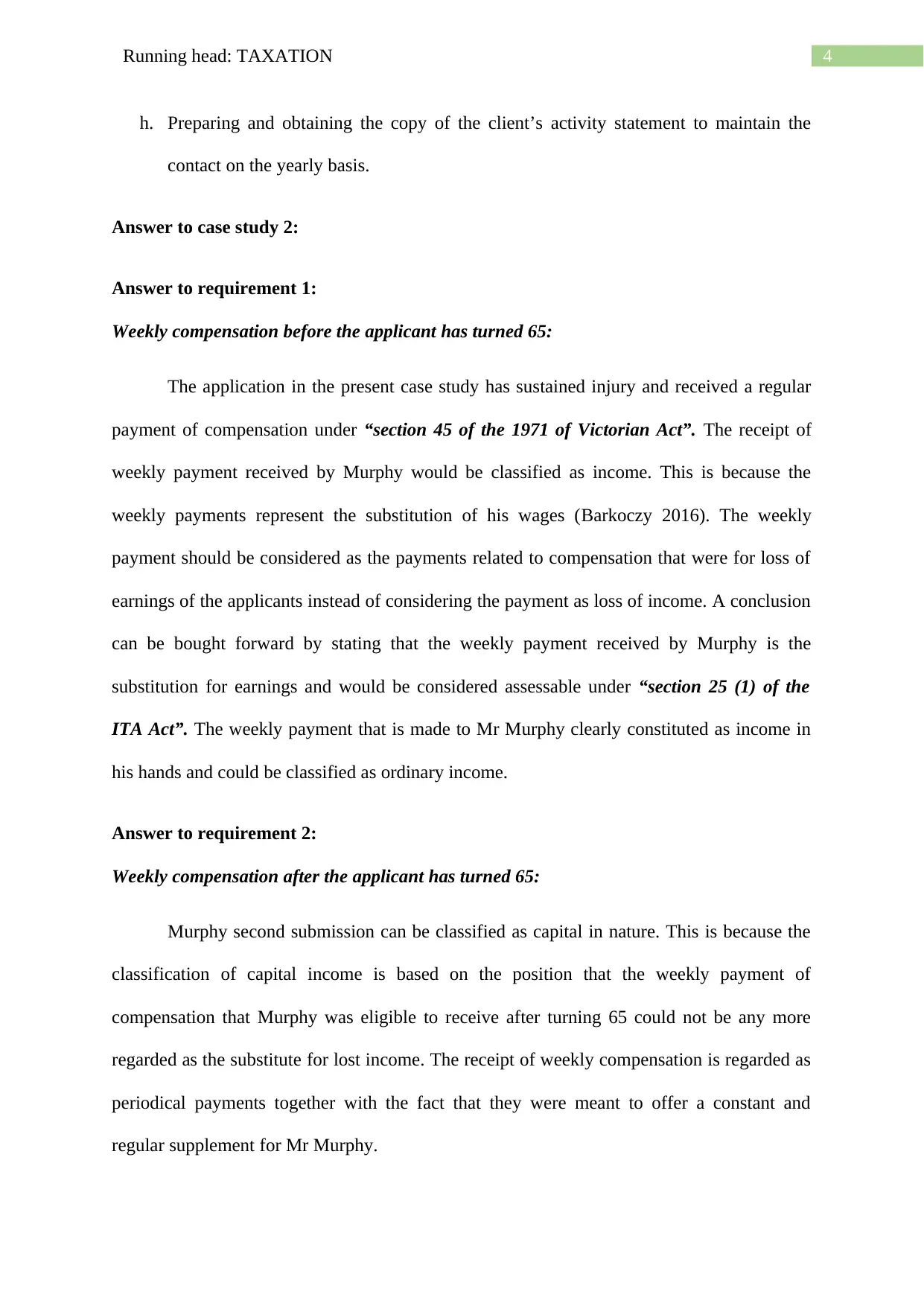
4Running head: TAXATION
h. Preparing and obtaining the copy of the client’s activity statement to maintain the
contact on the yearly basis.
Answer to case study 2:
Answer to requirement 1:
Weekly compensation before the applicant has turned 65:
The application in the present case study has sustained injury and received a regular
payment of compensation under “section 45 of the 1971 of Victorian Act”. The receipt of
weekly payment received by Murphy would be classified as income. This is because the
weekly payments represent the substitution of his wages (Barkoczy 2016). The weekly
payment should be considered as the payments related to compensation that were for loss of
earnings of the applicants instead of considering the payment as loss of income. A conclusion
can be bought forward by stating that the weekly payment received by Murphy is the
substitution for earnings and would be considered assessable under “section 25 (1) of the
ITA Act”. The weekly payment that is made to Mr Murphy clearly constituted as income in
his hands and could be classified as ordinary income.
Answer to requirement 2:
Weekly compensation after the applicant has turned 65:
Murphy second submission can be classified as capital in nature. This is because the
classification of capital income is based on the position that the weekly payment of
compensation that Murphy was eligible to receive after turning 65 could not be any more
regarded as the substitute for lost income. The receipt of weekly compensation is regarded as
periodical payments together with the fact that they were meant to offer a constant and
regular supplement for Mr Murphy.
h. Preparing and obtaining the copy of the client’s activity statement to maintain the
contact on the yearly basis.
Answer to case study 2:
Answer to requirement 1:
Weekly compensation before the applicant has turned 65:
The application in the present case study has sustained injury and received a regular
payment of compensation under “section 45 of the 1971 of Victorian Act”. The receipt of
weekly payment received by Murphy would be classified as income. This is because the
weekly payments represent the substitution of his wages (Barkoczy 2016). The weekly
payment should be considered as the payments related to compensation that were for loss of
earnings of the applicants instead of considering the payment as loss of income. A conclusion
can be bought forward by stating that the weekly payment received by Murphy is the
substitution for earnings and would be considered assessable under “section 25 (1) of the
ITA Act”. The weekly payment that is made to Mr Murphy clearly constituted as income in
his hands and could be classified as ordinary income.
Answer to requirement 2:
Weekly compensation after the applicant has turned 65:
Murphy second submission can be classified as capital in nature. This is because the
classification of capital income is based on the position that the weekly payment of
compensation that Murphy was eligible to receive after turning 65 could not be any more
regarded as the substitute for lost income. The receipt of weekly compensation is regarded as
periodical payments together with the fact that they were meant to offer a constant and
regular supplement for Mr Murphy.
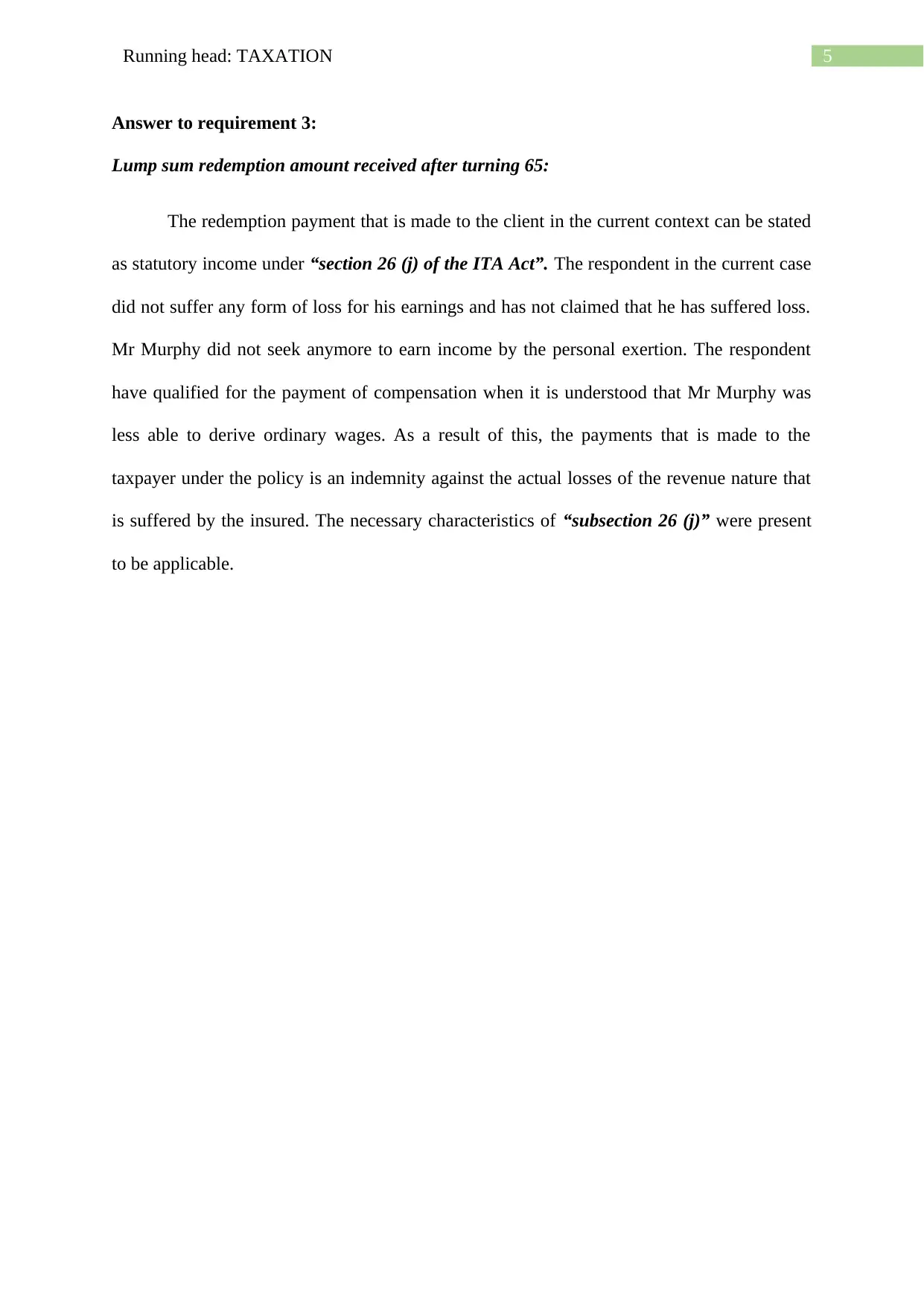
5Running head: TAXATION
Answer to requirement 3:
Lump sum redemption amount received after turning 65:
The redemption payment that is made to the client in the current context can be stated
as statutory income under “section 26 (j) of the ITA Act”. The respondent in the current case
did not suffer any form of loss for his earnings and has not claimed that he has suffered loss.
Mr Murphy did not seek anymore to earn income by the personal exertion. The respondent
have qualified for the payment of compensation when it is understood that Mr Murphy was
less able to derive ordinary wages. As a result of this, the payments that is made to the
taxpayer under the policy is an indemnity against the actual losses of the revenue nature that
is suffered by the insured. The necessary characteristics of “subsection 26 (j)” were present
to be applicable.
Answer to requirement 3:
Lump sum redemption amount received after turning 65:
The redemption payment that is made to the client in the current context can be stated
as statutory income under “section 26 (j) of the ITA Act”. The respondent in the current case
did not suffer any form of loss for his earnings and has not claimed that he has suffered loss.
Mr Murphy did not seek anymore to earn income by the personal exertion. The respondent
have qualified for the payment of compensation when it is understood that Mr Murphy was
less able to derive ordinary wages. As a result of this, the payments that is made to the
taxpayer under the policy is an indemnity against the actual losses of the revenue nature that
is suffered by the insured. The necessary characteristics of “subsection 26 (j)” were present
to be applicable.
⊘ This is a preview!⊘
Do you want full access?
Subscribe today to unlock all pages.

Trusted by 1+ million students worldwide
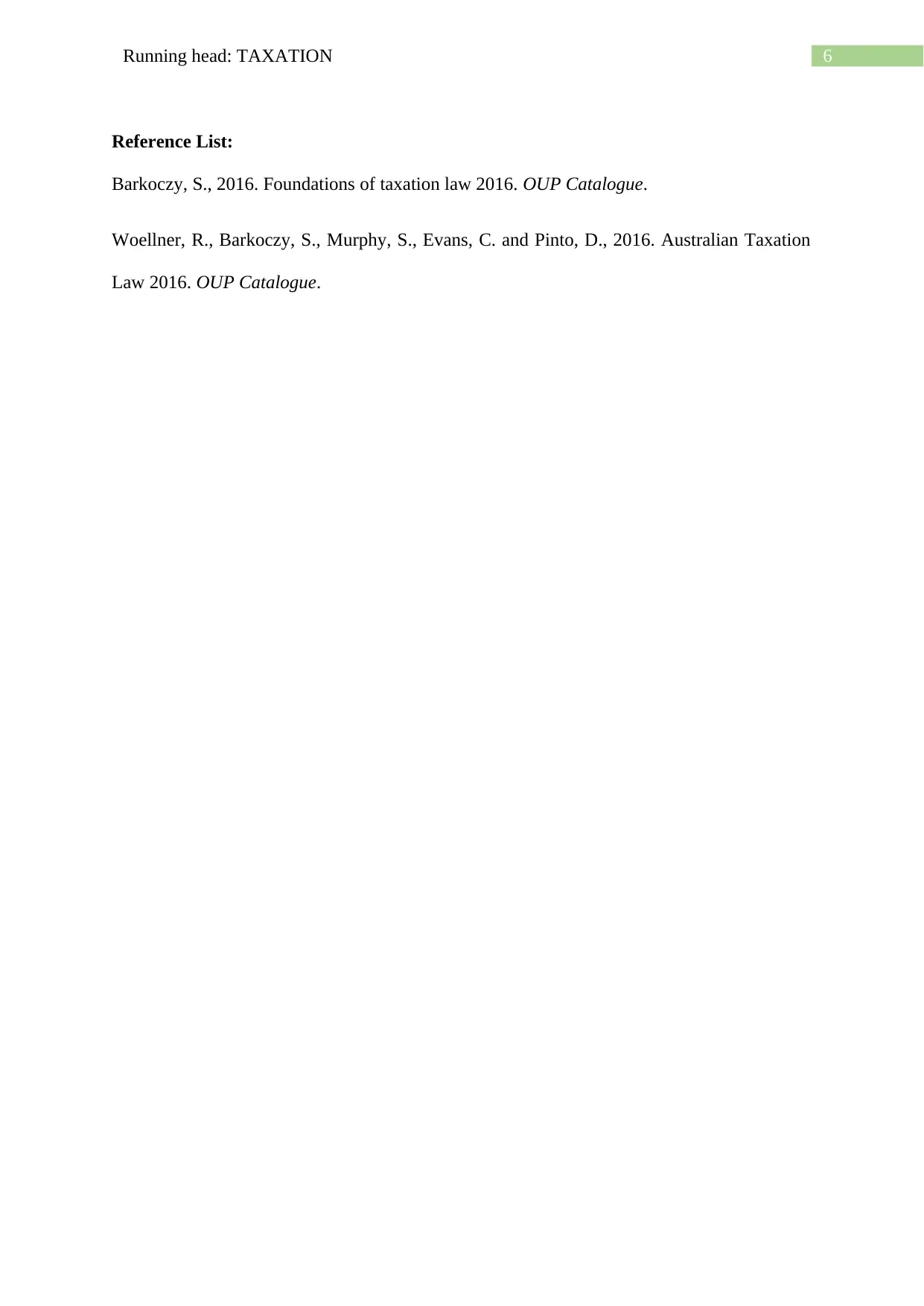
6Running head: TAXATION
Reference List:
Barkoczy, S., 2016. Foundations of taxation law 2016. OUP Catalogue.
Woellner, R., Barkoczy, S., Murphy, S., Evans, C. and Pinto, D., 2016. Australian Taxation
Law 2016. OUP Catalogue.
Reference List:
Barkoczy, S., 2016. Foundations of taxation law 2016. OUP Catalogue.
Woellner, R., Barkoczy, S., Murphy, S., Evans, C. and Pinto, D., 2016. Australian Taxation
Law 2016. OUP Catalogue.
1 out of 7
Related Documents
Your All-in-One AI-Powered Toolkit for Academic Success.
+13062052269
info@desklib.com
Available 24*7 on WhatsApp / Email
![[object Object]](/_next/static/media/star-bottom.7253800d.svg)
Unlock your academic potential
Copyright © 2020–2025 A2Z Services. All Rights Reserved. Developed and managed by ZUCOL.





